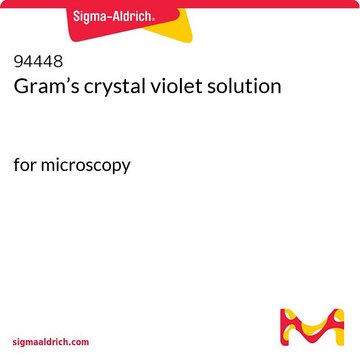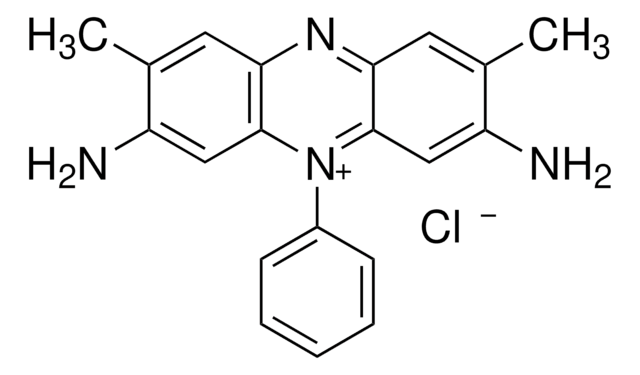About This Item
Recommended Products
form
aqueous solution
Quality Level
concentration
1%
technique(s)
microbe id | staining: suitable
color
deep violet, purple
Amax
0.36-0.44 at 589-594 nm
application(s)
diagnostic assay manufacturing
hematology
histology
storage temp.
room temp
SMILES string
[Cl-].CN(C)c1ccc(cc1)\C(c2ccc(cc2)N(C)C)=C3/C=C\C(C=C3)=[N+](/C)C
InChI
1S/C25H30N3.ClH/c1-26(2)22-13-7-19(8-14-22)25(20-9-15-23(16-10-20)27(3)4)21-11-17-24(18-12-21)28(5)6;/h7-18H,1-6H3;1H/q+1;/p-1
InChI key
ZXJXZNDDNMQXFV-UHFFFAOYSA-M
Looking for similar products? Visit Product Comparison Guide
General description
It stains the fatty portions of sebaceous sweat a deep purple color. Crystal violet can also be used to enhance bloody fingerprints. This dye is harmful if inhaled, swallowed or absorbed through skin, contact may cause cancer, severe eye irritation in human beings.
Application
- Crystal violet is commonly used in Gram staining for the classification of bacteria.
- It has also been used to detect bacterial adherence to biomedical polymers and to stain DNA in mammalian tissues in Giemsa staining.
- It has been successfully used to develop a counterion-staining method to detect DNA in agarose gel electrophoresis.
- Its antimicrobial properties have facilitated its use in the treatment of oral candidiasis, skin infections, and methicillin-resistant Staphylococcus aureus.
- It has been used as a stain in cell proliferation assays, migration assays, and Boyden chamber assay.
Biochem/physiol Actions
Principle
Signal Word
Warning
Hazard Statements
Precautionary Statements
Hazard Classifications
Aquatic Chronic 3 - Carc. 2 - Eye Irrit. 2
Storage Class Code
12 - Non Combustible Liquids
WGK
WGK 2
Flash Point(F)
Not applicable
Flash Point(C)
Not applicable
Regulatory Listings
Regulatory Listings are mainly provided for chemical products. Only limited information can be provided here for non-chemical products. No entry means none of the components are listed. It is the user’s obligation to ensure the safe and legal use of the product.
EU REACH Annex XVII (Restriction List)
Choose from one of the most recent versions:
Already Own This Product?
Find documentation for the products that you have recently purchased in the Document Library.
Customers Also Viewed
Related Content
An overview of the science and practice of bacteriology in clinical diagnostics. Learn more about the application of standard and special stains for microscopic analysis.
Our team of scientists has experience in all areas of research including Life Science, Material Science, Chemical Synthesis, Chromatography, Analytical and many others.
Contact Technical Service






